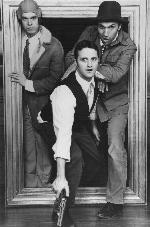SEARCH CurtainUp
REVIEWS
FEATURES
NEWS (Etcetera)
ADDRESS BOOKS
Broadway
Off-Broadway
BOOKS and CDs
OTHER PLACES
Berkshires
London
Los Angeles
Philadelphia
Elsewhere
QUOTES
On TKTS
LETTERS TO EDITOR
FILM
LINKS
MISCELLANEOUS
Free Updates
Masthead
NYC Weather
The Murals of Rockefeller Center
by Les Gutman
|
Memories seldom endure for more than a generation. |

J. Bachler, J. Lush and Sven Miller
(Photo: Gerry Goodstein) |
The Murals of Rockefeller Center seeks to remedy this situation a bit. It unearths the story of Diego Rivera (Sven Miller) and his mural depicting "man at the crossroads" -- two visions of America. The work was included in the lobby of the RCA Building (now, of course, known as the GE building), but was air-hammered into oblivion by the Rockefeller's when they discovered the face of Lenin in the finished work. "All art is propaganda," Rivera insisted. Indeed, and not the sort the heirs to the Standard Oil fortune were interested in propagating.
This story, conceived and written by Irondale Ensemble Project, needs context to be appreciated, and thus Murals limns the era, putting flesh on the bones of the Rockefeller-Rivera confrontation. It is historically-based, but as Rivera acknowledges early on, utilizes the art of invention when needed to reveal the "truth". Right at the surface, it explores the broader question with which Rivera's work provokes us: just how do we define a hero?
There is perhaps no single period in the 20th Century that is more intriguing than this one, or with more people vying for the title of hero. Just consider a few of the names mixing it up onstage in this production: Rockefeller -- John D., Jr. (Michael-David Gordon), John D., III (Josh Bacher) and Nelson (Jack Lush); Lindbergh -- Charles (Josh Bacher, again) and his wife, Ann Morrow (Missy Jayme); Dillinger (Lush, again); Picasso (also Bacher); Matisse (also Lush); Ford -- Henry, that is (Damen Scranton); Hoover -- J. Edgar (also Scranton) as well as the defrocked Mexican Communist artist, Rivera, briefly the darling of the American philanthropy set, and his wife, Frida Kahlo (Patrena Murray). Among, I might add, quite a few others.
Rivera serves as our tour guide, and in Sven Miller's hands, he is most endearing. He pops in and out of the story, annotating for us as he goes along. We come to know him as artist, Mexican, Communist, husband and simply as a man. An early scene in which the Rockefeller father and sons concoct the idea for their daring real estate venture is a frantic, comedic delight in which all three performers are brilliant. It's a standard these characterizations will maintain throughout.
Soon, we will be introduced to other "heroes" as Lindbergh, fresh back from his trans-Atlantic feat, becomes the toast of New York, and then John Dillinger is woven in. It's an interesting dissection of the forces at play in this between-the-wars, in-the-midst-of-Depression time, but it eventually causes the play to lose its focus. Jim Niessen, whose overall direction is excellent and who, with his exceptional design team, does much much to establish our sense of place, becomes bogged down in side stories that have nothing to do with the one he is telling. We could understand the significance of Dillinger just as much, for instance, without having to sit through a detailed reënactment of his death, and we didn't need a late-in-the-play detour into Lindbergh's subsequent cozy-up with Hitler just when Rivera was driving his own point home. The actors playing both men were better when they were Rockefellers, and the details of their private lives could have been substantially excised as well. That said, there is far more here to praise than complain about.
As is always the case, Irondale's productions are embellished by the music of The Walter Thompson Orchestra. This time, their contribution includes a particularly well-performed little concert that begins when the doors to the theater are opened to the audience. So getting to the show early pays a nice dividend.
Ken Rothchild's terrific set design for this production, filled with steel ramps, grates and scaffolding, has only one major drawback: it sacrifices roughly one-third of the seats that would otherwise be available for patrons. In this case, that's a shame; it means that many fewer people will be able to enjoy the many enticements of Irondale's latest production.
|
The Murals of Rockefeller Center
by Jim Niesen and the Irondale Ensemble Project Directed by Jim Niesen with Danny Bacher, Josh Bacher, Michael-David Gordon, Missy Jayme, Jack Lush, Sven Miller, Patrena Murray and Damen Scranton Set Design: Ken Rothchild Costume Design: T. Michael Hall Lighting Design: Randy Glickman Original Music: Walter Thompson Music performed by members of the Walter Thompson Orchestra Running Time: 2 hours, 15 minutes with 1 intermission A production of the Irondale Ensemble Project Theatre For the New City, 155 First Avenue (9/10 Sts) Telephone (718) 488-9233 Irondale website: www.irondale.org Opening April 24, 2002, closing May 18, 2002 TUES - SAT @8; $25, $15 for students and seniors (Thursday performances are "pay-what-you-wish" and include a talkback with the ensemble) Reviewed by Les Gutman based on 4/23/02 performance |

6,500 Comparative Phrases including 800 Shakespearean Metaphors by CurtainUp's editor.
Click image to buy.
Go here for details and larger image.



